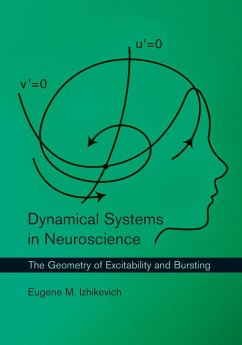Explains the relationship of electrophysiology, nonlinear dynamics, and the computational properties of neurons, with each concept presented in terms of both neuroscience and mathematics and illustrated using geometrical intuition.
In order to model neuronal behavior or to interpret the results of modeling studies, neuroscientists must call upon methods of nonlinear dynamics. This book offers an introduction to nonlinear dynamical systems theory for researchers and graduate students in neuroscience. It also provides an overview of neuroscience for mathematicians who want to learn the basic facts of electrophysiology.
Dynamical Systems in Neuroscience presents a systematic study of the relationship of electrophysiology, nonlinear dynamics, and computational properties of neurons. It emphasizes that information processing in the brain depends not only on the electrophysiological properties of neurons but also on their dynamical properties. The book introduces dynamical systems, starting with one- and two-dimensional Hodgkin-Huxley-type models and continuing to a description of bursting systems. Each chapter proceeds from the simple to the complex, and provides sample problems at the end. The book explains all necessary mathematical concepts using geometrical intuition; it includes many figures and few equations, making it especially suitable for non-mathematicians. Each concept is presented in terms of both neuroscience and mathematics, providing a link between the two disciplines.
Nonlinear dynamical systems theory is at the core of computational neuroscience research, but it is not a standard part of the graduate neuroscience curriculum or taught by math or physics department in a way that is suitable for students of biology. This book offers neuroscience students and researchers a comprehensive account of concepts and methods increasingly used in computational neuroscience.
An additional chapter on synchronization, with more advanced material, can be found at the author's website, www.izhikevich.com.
In order to model neuronal behavior or to interpret the results of modeling studies, neuroscientists must call upon methods of nonlinear dynamics. This book offers an introduction to nonlinear dynamical systems theory for researchers and graduate students in neuroscience. It also provides an overview of neuroscience for mathematicians who want to learn the basic facts of electrophysiology.
Dynamical Systems in Neuroscience presents a systematic study of the relationship of electrophysiology, nonlinear dynamics, and computational properties of neurons. It emphasizes that information processing in the brain depends not only on the electrophysiological properties of neurons but also on their dynamical properties. The book introduces dynamical systems, starting with one- and two-dimensional Hodgkin-Huxley-type models and continuing to a description of bursting systems. Each chapter proceeds from the simple to the complex, and provides sample problems at the end. The book explains all necessary mathematical concepts using geometrical intuition; it includes many figures and few equations, making it especially suitable for non-mathematicians. Each concept is presented in terms of both neuroscience and mathematics, providing a link between the two disciplines.
Nonlinear dynamical systems theory is at the core of computational neuroscience research, but it is not a standard part of the graduate neuroscience curriculum or taught by math or physics department in a way that is suitable for students of biology. This book offers neuroscience students and researchers a comprehensive account of concepts and methods increasingly used in computational neuroscience.
An additional chapter on synchronization, with more advanced material, can be found at the author's website, www.izhikevich.com.
A unique contribution to the theoretical neuroscience literature that can serve as a useful reference for audiences ranging from quantitatively skilled undergraduates interested in mathematical modeling, to neuroscientists at all levels, to graduate students and even researchers in the field of theoretical neuroscience. Jonathan E. Rubin, Mathematical Review









